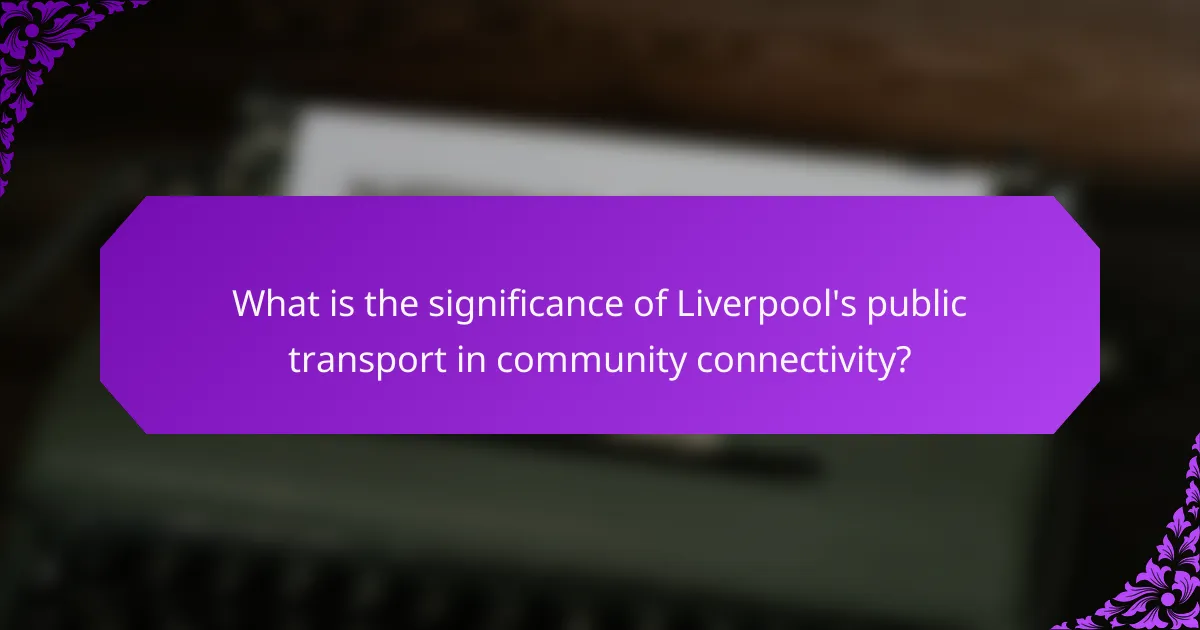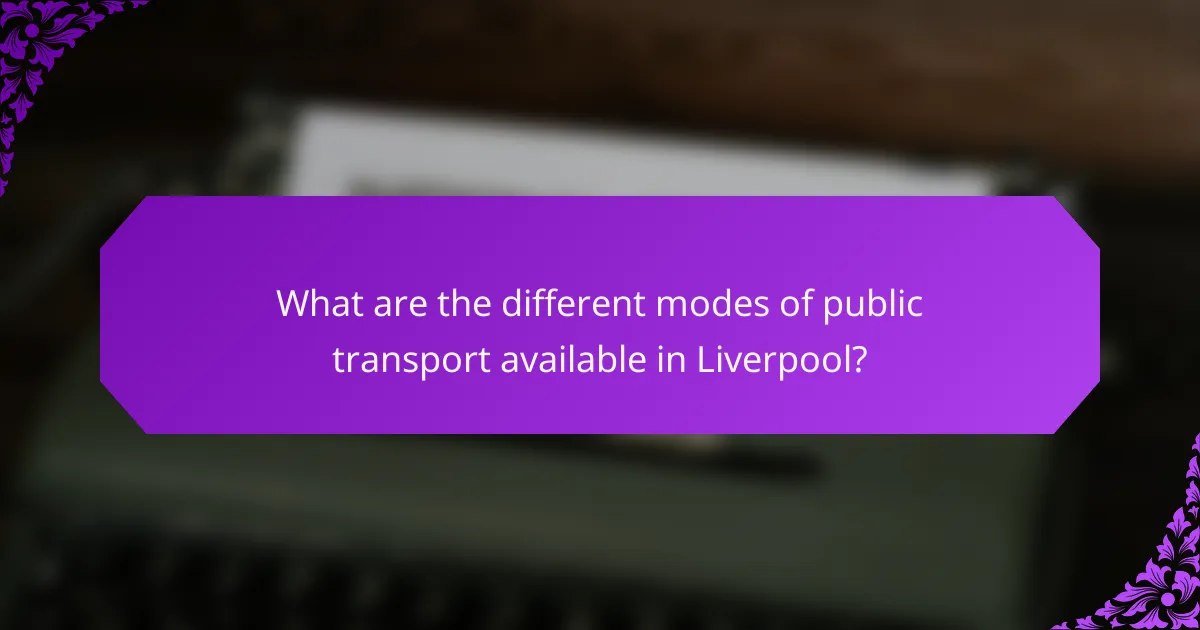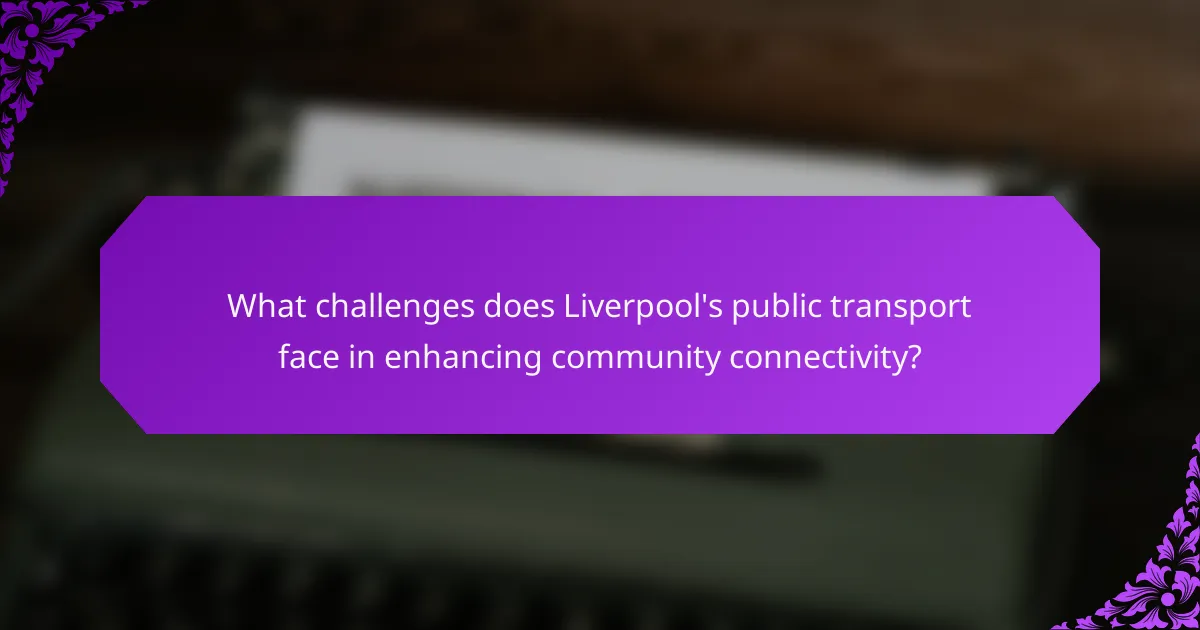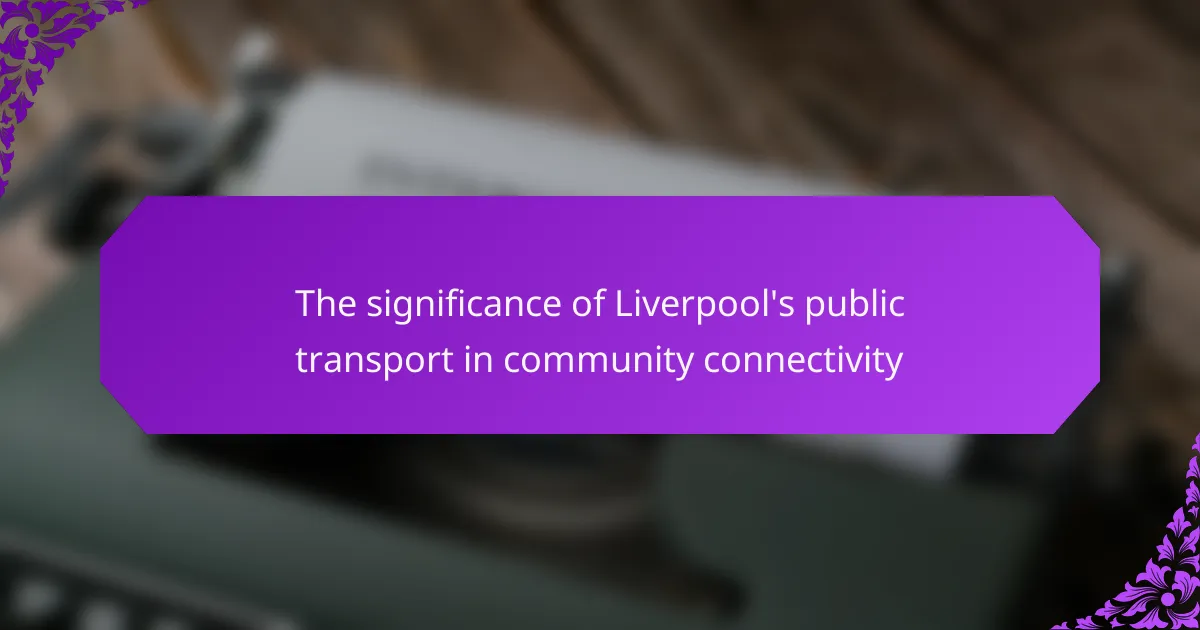Liverpool’s public transport system is essential for enhancing community connectivity within the city. It encompasses various modes, including buses, trains, ferries, and the Merseyrail network, which facilitate movement across neighborhoods and promote social interaction and economic opportunities. However, challenges such as insufficient coverage, high congestion, aging infrastructure, and limited funding hinder its effectiveness. The article will examine the significance of Liverpool’s public transport in fostering local development and the obstacles it faces in providing reliable service to residents.

What is the significance of Liverpool’s public transport in community connectivity?
Liverpool’s public transport is crucial for enhancing community connectivity. It provides accessible and reliable options for residents to travel within the city. The network includes buses, trains, and ferries, facilitating movement across diverse neighborhoods. This connectivity fosters social interaction and economic opportunities. Studies show that efficient public transport systems correlate with increased local business activity. Additionally, public transport reduces traffic congestion and environmental impact. The Merseyrail system, for example, connects urban areas to suburban regions effectively. Overall, Liverpool’s public transport plays a vital role in uniting the community and supporting local development.
How does Liverpool’s public transport system facilitate community interactions?
Liverpool’s public transport system facilitates community interactions by providing accessible and affordable travel options. Buses, trains, and ferries connect various neighborhoods and key community hubs. This connectivity encourages social engagement among residents. Public transport also reduces travel times, making it easier for people to attend local events and gatherings. The Merseyrail network, for instance, links the city center with surrounding areas efficiently. Additionally, the integration of services promotes inclusivity and reduces isolation. Community initiatives often leverage public transport for outreach and participation. Overall, the public transport system plays a crucial role in enhancing community cohesion in Liverpool.
What are the key components of Liverpool’s public transport network?
Liverpool’s public transport network consists of buses, trains, and ferries. Buses provide extensive coverage throughout the city and surrounding areas. The Merseyrail train system connects Liverpool to nearby towns and the wider region. Ferries operate across the River Mersey, linking Liverpool with the Wirral. Additionally, the network includes taxis and private hire vehicles for flexible transport options. Information on services and schedules is accessible through various platforms, aiding user navigation. The integration of these components facilitates efficient travel for residents and visitors alike.
How do these components enhance accessibility for residents?
The components of Liverpool’s public transport system enhance accessibility for residents by providing reliable and efficient transportation options. These options include buses, trains, and ferries that connect various neighborhoods and key destinations. Accessibility features, such as low-floor buses and audio-visual announcements, cater to individuals with mobility challenges. Additionally, integrated ticketing systems simplify fare payment across different transport modes. Research shows that improved public transport leads to a 20% increase in community engagement and mobility. This evidence highlights the positive impact of accessible transport on residents’ daily lives and overall community connectivity.
Why is public transport crucial for local communities in Liverpool?
Public transport is crucial for local communities in Liverpool as it enhances accessibility and mobility. It connects residents to essential services, including healthcare, education, and employment opportunities. According to the Liverpool City Region Combined Authority, 60% of residents rely on public transport for daily commuting. This reliance supports economic growth by facilitating access to local businesses. Public transport also reduces traffic congestion and lowers carbon emissions, contributing to environmental sustainability. Furthermore, it promotes social inclusion by enabling individuals without private vehicles to participate in community activities. Thus, public transport plays a vital role in fostering interconnected and thriving local communities in Liverpool.
What impact does public transport have on social inclusion?
Public transport significantly enhances social inclusion by providing access to essential services and opportunities. It connects marginalized communities to employment, education, and healthcare. Studies show that regions with robust public transport systems experience lower levels of social isolation. In Liverpool, public transport facilitates mobility for low-income residents, promoting participation in community activities. Accessibility features in public transport further support individuals with disabilities. Research indicates that improved transport links correlate with increased social interactions among diverse groups. Overall, public transport plays a crucial role in fostering inclusive communities.
How does public transport contribute to economic opportunities in Liverpool?
Public transport in Liverpool enhances economic opportunities by improving access to jobs and services. It connects residents to various employment hubs across the city. This connectivity reduces travel time and costs for commuters. A well-functioning public transport system encourages businesses to invest in the area. Increased foot traffic from public transport users can boost local economies. For instance, the Merseyrail network supports over 23 million passenger journeys annually. This volume of use demonstrates the system’s role in facilitating economic activity. Additionally, public transport contributes to attracting tourism, further stimulating local businesses.

What are the different modes of public transport available in Liverpool?
Liverpool offers several modes of public transport. These include buses, trains, ferries, and the Merseyrail network. Buses operate extensively throughout the city and surrounding areas. They are managed by various companies, providing frequent services. The train services connect Liverpool to other cities and regions. The Merseyrail network specifically serves the metropolitan area. Ferries operate on the River Mersey, connecting Liverpool with the Wirral Peninsula. Additionally, taxis and ride-sharing services are available. Each mode plays a crucial role in enhancing community connectivity.
How do buses serve the public transport needs in Liverpool?
Buses serve the public transport needs in Liverpool by providing accessible and affordable transportation options. They connect various neighborhoods to key destinations, including workplaces, schools, and healthcare facilities. Liverpool’s bus network operates frequently, ensuring minimal wait times for commuters. The buses are equipped to accommodate individuals with disabilities, enhancing inclusivity. According to the Merseytravel report, over 40 million bus journeys occur annually in Liverpool. This high usage indicates their importance in daily commuting. Additionally, bus services reduce traffic congestion and lower carbon emissions, contributing to environmental sustainability. Overall, buses play a crucial role in enhancing community connectivity in Liverpool.
What routes are most popular among commuters?
The most popular routes among commuters in Liverpool include the 86, 500, and 10 buses. These routes connect key areas such as the city center, residential neighborhoods, and major employment zones. The 86 bus runs frequently, providing access to various communities. The 500 route is known for its express service, reducing travel time significantly. The 10 bus serves a high-density residential area, making it a vital option for daily commuters. According to Merseytravel, these routes experience high passenger volumes, reflecting their importance in the public transport network.
How do bus services adapt to community needs?
Bus services adapt to community needs by adjusting routes, schedules, and services based on local demand. They conduct surveys and gather feedback from residents to identify specific needs. This data informs changes to service frequency and route coverage. For example, bus services may increase frequency during peak hours to accommodate commuters. They may also introduce new routes to connect underserved areas. Additionally, partnerships with local organizations can enhance service offerings. In Liverpool, these adaptations help ensure accessibility and convenience for all community members. The effectiveness of these adaptations can be seen in increased ridership and improved satisfaction ratings from users.
What role do trains play in Liverpool’s public transport system?
Trains are a vital component of Liverpool’s public transport system. They provide efficient and reliable transportation for residents and visitors. The Merseyrail network connects Liverpool to surrounding areas, enhancing accessibility. This network operates frequent services, reducing travel time across the region. Trains help alleviate road congestion by offering an alternative mode of transport. They also promote sustainable travel by reducing carbon emissions. Additionally, train stations serve as hubs for other transport options, facilitating seamless transfers. Overall, trains significantly contribute to community connectivity in Liverpool.
Which train lines are vital for community connectivity?
The vital train lines for community connectivity in Liverpool include the Merseyrail network. This network connects key areas such as Liverpool city center, Southport, and Chester. The Northern Line and Wirral Line are essential branches of the Merseyrail system. They facilitate access to residential neighborhoods and employment hubs. Statistics show that Merseyrail serves over 30 million passengers annually. This high ridership indicates its importance for daily commutes and social connectivity. The train lines also link to bus services, enhancing overall public transport integration. Thus, they play a crucial role in fostering community engagement and mobility.
How do train services integrate with other transport modes?
Train services integrate with other transport modes through coordinated schedules and shared facilities. This allows for seamless transfers between trains, buses, trams, and ferries. For example, stations often feature bus terminals adjacent to train platforms. Timetables are aligned to minimize waiting times for passengers. Additionally, integrated ticketing systems allow users to purchase a single ticket for multiple transport modes. This integration enhances overall accessibility and convenience for commuters. Studies show that cities with well-integrated transport systems experience increased public transport usage. In Liverpool, the Merseyrail network connects effectively with local buses and ferries, promoting community connectivity.

What challenges does Liverpool’s public transport face in enhancing community connectivity?
Liverpool’s public transport faces several challenges in enhancing community connectivity. Insufficient coverage in certain areas limits access for residents. High congestion on major routes leads to delays and reduces reliability. Aging infrastructure requires significant investment for upgrades. Limited funding restricts the expansion of services and routes. Additionally, poor integration between different transport modes complicates travel for users. These factors collectively hinder the effectiveness of public transport in connecting communities across Liverpool.
How do funding issues affect public transport services?
Funding issues lead to reduced public transport services. Limited financial resources result in fewer routes and less frequent service. This can cause longer wait times for passengers. Budget constraints may also lead to delayed maintenance and upgrades. Poorly maintained vehicles can increase safety risks for commuters. Inadequate funding can hinder the implementation of new technologies. This affects the efficiency and reliability of public transport. According to the American Public Transportation Association, 73% of transit agencies reported service cuts due to funding shortfalls. These cuts can diminish community connectivity and accessibility.
What are the implications of service cuts on community access?
Service cuts significantly reduce community access to essential resources. This leads to decreased mobility for residents, limiting their ability to reach jobs, education, and healthcare. Studies show that areas with reduced public transport services experience higher rates of unemployment and social isolation. For instance, a report from the Institute for Transport Studies indicates that service reductions can lead to a 20% drop in public transport usage. This impacts vulnerable populations who rely on these services the most, exacerbating inequalities within the community. Overall, service cuts hinder community connectivity and economic opportunities.
What measures are being taken to improve public transport in Liverpool?
Liverpool is implementing several measures to enhance its public transport system. These include investing in new bus and train services. The city is also upgrading existing infrastructure to improve efficiency. Additionally, there are plans to introduce more environmentally friendly vehicles. Funding from the government supports these initiatives. Recent reports indicate a focus on increasing accessibility for all users. Enhanced technology for real-time information is being integrated into the system. The overall goal is to create a more reliable and user-friendly public transport experience.
How are community feedback and involvement shaping transport policies?
Community feedback and involvement are crucial in shaping transport policies. Local authorities often gather input through surveys, public meetings, and social media. This feedback helps identify community needs and preferences regarding transport options. For instance, in Liverpool, residents have expressed a desire for more reliable bus services. As a result, transport planners have adjusted routes and schedules to better serve these areas. Additionally, community involvement fosters transparency and trust in decision-making processes. Studies show that policies reflecting community input lead to higher satisfaction and usage rates. Overall, active participation ensures that transport policies align with the actual needs of the community.
What innovations are being introduced to enhance service quality?
Innovations being introduced to enhance service quality in Liverpool’s public transport include the implementation of real-time tracking systems. These systems provide passengers with accurate arrival and departure times. Mobile applications are also being developed to improve user experience. These apps offer features such as route planning and service alerts. Additionally, contactless payment options are being expanded to streamline fare collection. Enhanced customer service training for staff is being prioritized to improve interactions with passengers. These innovations aim to increase overall satisfaction and efficiency in public transport services.
What best practices can be adopted to maximize the benefits of Liverpool’s public transport?
To maximize the benefits of Liverpool’s public transport, users should plan their journeys in advance. Utilizing real-time tracking apps can enhance efficiency. Familiarizing oneself with the network routes is essential for smooth travel.
Regularly checking for service updates helps avoid delays. Engaging in off-peak travel can lead to a more comfortable experience. Purchasing travel passes can save money for frequent users.
Lastly, providing feedback to transport authorities can lead to improvements in services. These practices collectively enhance the overall effectiveness of Liverpool’s public transport system.
Liverpool’s public transport system is a critical entity for enhancing community connectivity, comprising buses, trains, and ferries that provide accessible and reliable travel options for residents. The article explores how this network facilitates social interactions, supports local economic growth, and promotes inclusivity by connecting diverse neighborhoods and essential services. It also addresses the challenges faced by the transport system, including funding issues and infrastructure needs, while highlighting ongoing improvements and innovations aimed at enhancing service quality. Ultimately, the significance of Liverpool’s public transport in fostering interconnected and thriving communities is underscored throughout the discussion.
